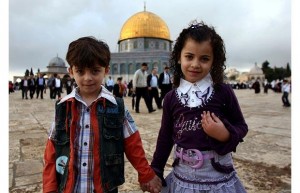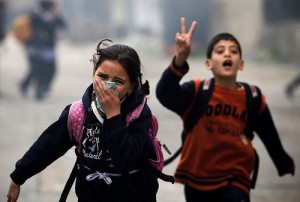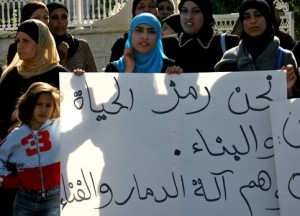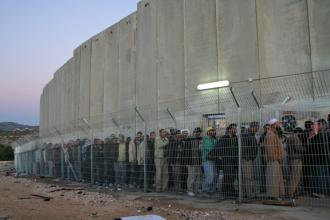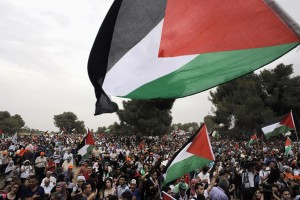“There are Arab citizens in the State of Israel. This is our greatest sorrow.”
– Public Security Minister Gideon Ezra in 2004
Palestinian citizens of Israel
The Palestinian population of Israel consists of original inhabitants of the territory that became Israel in 1948 as well as Palestinians who were living in lands occupied after the Six Day War of 1967 (in East Jerusalem and the Golan Heights) (1). By 2010, they numbered 1,617,000, more than 20% of the total population.
As Ben White states in Palestinians in Israel, “The struggle of Israel’s second-class citizens is poorly understood and ignored by the official peace process. Despite decades of coercion and control (including a generation of martial law), many of these Palestinian citizens are more determined than ever to challenge the structural discrimination and racist legislation which shape their lives.”
Members of this group refer to themselves as Palestinian citizens of Israel, although the Israeli establishment insists on calling them Israeli Arabs (2). They speak the Palestinian dialect of Arabic. They are primarily Muslim, although some are Christian or Druze. While the majority identify themselves as Palestinian, the Bedouins in the Naqab (Negev) and the Druze in the north tend to identify as Israelis. This, however, is beginning to change as Bedouin are seeing the common struggle between Palestinians and themselves, and are starting to identify increasingly as Palestinian (3).
About 46 percent of the country’s Palestinian population lives in predominantly Arab communities in the north. Nazareth is the largest Palestinian city although Jerusalem has the largest Palestinian population.
The Muslim Palestinian population is very young; their median age is 18, as compared to 30 for Jewish Israelis. Many have family ties to Palestinians in the West Bank and Gaza Strip as well as in refugee camps in Jordan, Syria, and Lebanon. Most Druze live in the Golan Heights. From the time of the British Mandate onward, they have distanced themselves from Arab/Islamic concerns (4); they enjoy a separate status from other Palestinian Israelis. Christian Palestinians (9 percent of the population) also live mainly in the north. They are the most educated group of Palestinians and have been politically prominent compared to their Muslim brethren.
Some Palestinians from the West Bank and Gaza became citizens under early Family Unification Laws, before those laws became more exclusionary. On 31 July 2003, Israel passed a law denying citizenship and Israeli residence to Palestinians in the West Bank or Gaza Strip who marry Israelis. This law is considered discriminatory by the United Nations Committee on the Elimination of Racial Discrimination.
The Palestinian population is now a majority in two regions, the Galilee and the Triangle (towns and villages adjacent to the Green Line). This is a source of anxiety for the government. Palestinian citizens are spoken of as a “demographic threat” in mainstream discourse because their birth rate is higher than Jewish Israelis (5). Historian Benny Morris has compared Palestinian Israelis to a “time bomb” and “a potential fifth column,” liable to undermine the state in times of war. The phrase used by the current prime minister, Benjamin Netanyahu, was “demographic bomb (6).” Corresponding increases in the Jewish population are mainly due to the the high birth rate of the Haredim (ultra-Orthodox).
After 1949, the Palestinian community began to change from a peasant farming population to an industrial workforce. From 1967 on, a Palestinian middle class developed on the margins of the Jewish bourgeoisie.
Relations with the larger state
This relationship is best described in a remark made by a Palestinian Israeli public figure who was interviewed by the commission set up to investigate the Palestinian killings during the Second Intifada: “My state is at war with my nation (7).”
“How Israel has related to the Palestinian minority is impossible to understand without seeing how denying democracy has been part of the Zionist colonization of Palestine from the very beginning,” argues Ben White (8). Palestinian Israelis want Israel to become a state of all its citizens, and this leads to tension, given the Jewish-Israeli insistence that it is a Jewish state. The 2006 report, The Future Vision of the Palestinian Arabs in Israel, asserts: “Defining the Israeli State as a Jewish State and exploiting democracy in the service of its Jewishness excludes us.” The Star of David at the center of the national flag is an exclusively Jewish symbol, and Hatikvah, the national anthem, does not represent Palestinian citizens, since it speaks of the Jewish people’s desire to return to their homeland. The “Jewish State” concept is grounded in preferential treatment of Jews , enshrined in immigration (the Law of Return) and land policy (the Jewish National Fund and the Jewish Agency). Palestinians can be citizens, but never nationals, as confirmed recently through a Supreme Court decision that ruled out the possibility of an “Israeli” nationality (9).
Tensions between the state and its minority population grew in 2006 with the inclusion of the right wing Yisrael Beiteinu party in Ehud Olmert’s government. Party leader Avigdor Lieberman proposed a plan that would transfer Arab areas of Israel to the Palestinian Authority and incorporate Jewish settlement blocs in the West Bank into Israel. Since 2000, Israeli lawmakers have passed a series of aggressively discriminatory laws. “The Jewish state,” Arthur Hertzberg wrote, “is thus an enterprise in which the Arabs are not equal partners, in which their interests are placed below those of a different national group–most of whose members are newcomers to the land, and many of whom are not even living in the country (10).”
Palestinian consciousness has intensified since the 1967 war, even though public expressions of identity–displays of the Palestinian flag or the singing and reciting of nationalist songs or poetry–were illegal until recently (11). There has been considerable political activity among this population, notably the 1975 election of Tawfiq Ziad, a poet, as mayor of Nazareth. The Islamic Movement of the 1980s, in addition to constructing schools and mosques and encouraging Muslim observances, also had an impact on local politics (12). Palestinian citizens of Israel supported the First Intifada (1987-1991), provided Palestinians in the Occupied Territories with money, food, and clothes, and held protest strikes in solidarity with them (13).
After the killing of 12 Palestinian citizens and a man from Gaza in October 2000, during the Second Intifada, Palestinian citizens boycotted the 2001 Israeli elections in protest. Ironically, this led to the victory of Ariel Sharon. To this day, not one police officer, commander or political leader has been held accountable for the murder of 12 Palestinian citizens of Israel.
Minority rights in theory and in fact
Israel’s Declaration of Independence called for the establishment of a Jewish state with equality of social and political rights, regardless of religion, race, or sex. However, Palestinian citizens lived under martial law, subject to curfew, detention, expulsion and restrictive travel conditions. Martial law was lifted in 1966, and Palestinians citizens were then granted the same freedom of movement as Jewish citizens. The Palestinian minority could vote and were entitled to municipal services. The Israeli Ministry of Foreign Affairs states that the only legal distinction between Arab and Jewish citizens is that the former are exempted from compulsory service in the Israel Defense Forces. This, however, is a source of decided inequality since those who do not serve in the army have less access to social and economic benefits, such as housing, new-household subsidies and employment. It has also been demonstrated by Adalah—the Legal Center for Arab Minority Rights in Israel— that more than 50 laws discriminate against Palestinian citizens of Israel (14).
There are three mainstream Palestinian parties in Israel: Hadash (a joint Palestinian-Jewish party), Balad, and the United Arab List (a coalition of several political organizations including the Islamic Movement). Palestinian Knesset members have served in office since the very first meeting of that body. Palestinians were appointed as Ministers without Portfolio in 2001 and 2007. However, according to a study commissioned by the Arab Association of Human Rights, over the past three years, eight of nine Palestinian Knesset members have been beaten by Israeli forces during demonstrations. In the same period, legislation has been passed significantly curbing the minority right to choose a public representative who can develop an independent political platform (15). It is also worth noting that in the history of the state of Israel there has never been an Arab party that has been part of a governing coalition (16).
Palestinian citizens of Israel experience active discrimination—a practice that is eased by the fact that Israel has remained in an official “state of emergency” since 1948. Although they make up about 20 percent of the total population, less than 7 percent of goods and services are allocated to them. Although the Palestinian minority is entitled to the protection of the state, Palestinian communities were left open to attack during the 2006 Lebanon War due to a lack of bomb shelters and basic emergency information in Arabic (17). This inequality has been documented in many surveys and studies and has been confirmed in court judgements, government resolutions, reports and other official documents. Although the Jewish majority’s awareness of this discrimination may be low, it plays a central role in the sensibilities and attitudes of Palestinian citizens.
The Or Commission of Inquiry reported that “Government handling of the Arab sector has been primarily neglectful and discriminatory” and that the Government “did not show sufficient sensitivity to the needs of the Arab population, and did not take enough action to allocate state resources in an equal manner.” As a result, “serious distress prevailed in the Arab sector in various areas. Evidence of distress included poverty, unemployment, a shortage of land, serious problems in the education system, and substantially defective infrastructure.”
The state spends on average 35 per cent more on each Jewish than Palestinian citizen (18). Discrimination is present in all areas of political and social life. In 2003, close to half of all Palestinian families lived in poverty compared to around one quarter of Jewish Israeli families (19). Schools have a budget of around US $1,100 per year for each Jewish student, and $191 for each Palestinian student. The impact of this discriminatory funding is reflected in facilities, teaching quality and class sizes.
Arabic is one of Israel’s official languages, but not all government publications are published in it; publishing a law in Hebrew in the official gazette is enough to make it valid. “According to a 2003 University of Haifa study, Arab citizens get heavier prison terms than Jewish citizens,” and there is a long history of a lack of accountability for state forces that carry out violence against Palestinian citizens (20). Similar discrepancies are reflected in every category of daily life.
Land appropriation and home demolitions
While Upper Nazareth’s 50,000 inhabitants occupy 42,000 dunams of land, down the hill, 70,000 Palestinians are crammed into 14,000 dunams (21). An endless series of laws, legal manoeuvres and aggressive practices have been put in place since 1948 in order to acquire Palestinian land for the Jewish state. In 1976, six Palestinian citizens were killed by security forces at a protest against land expropriations and house demolitions, and that day, 30 March, is commemorated by Palestinians annually as Land Day.
Palestinians who fled their homes in 1948 (due largely to a deliberate effort by the Haganah and Israel Defence Forces to remove them from the land), even for other parts of what became the Israeli state, were refused permission to return: one out of every four Palestinian citizens of Israel was internally displaced in this way (22). Hussein Abu Hussein and Fiona McKay have suggested that “the figure of an average of at least 70% of land lost to the Palestinian communities is plausible (23).” Much of the appropriated land is held by the Jewish National Fund (JNF) rather than the government itself because it was feared that the latter arrangement could be interpreted as confiscation of the “abandoned” properties. The JNF currently owns roughly 13 percent of land in the state, and has significant influence over a further 80 percent of the land, through appointing nearly half of all members to the Israel Land Council. This is problematic from the viewpoint of Israeli democracy, since according to the JNF, “The loyalty of the JNF is given to the Jewish people and only to them is the JNF obligated (24).”
It is still extremely difficult, if not virtually impossible for Palestinian Israelis to lease nationalized, public land or get building permits. Since 1948, over 700 Jewish communities have been established; in the same period, not one new city, town or village has been created for the Palestinian minority, except for the seven towns in the Naqab designed to concentrate the Bedouins on the minimum amount of land (25).
The Bedouins
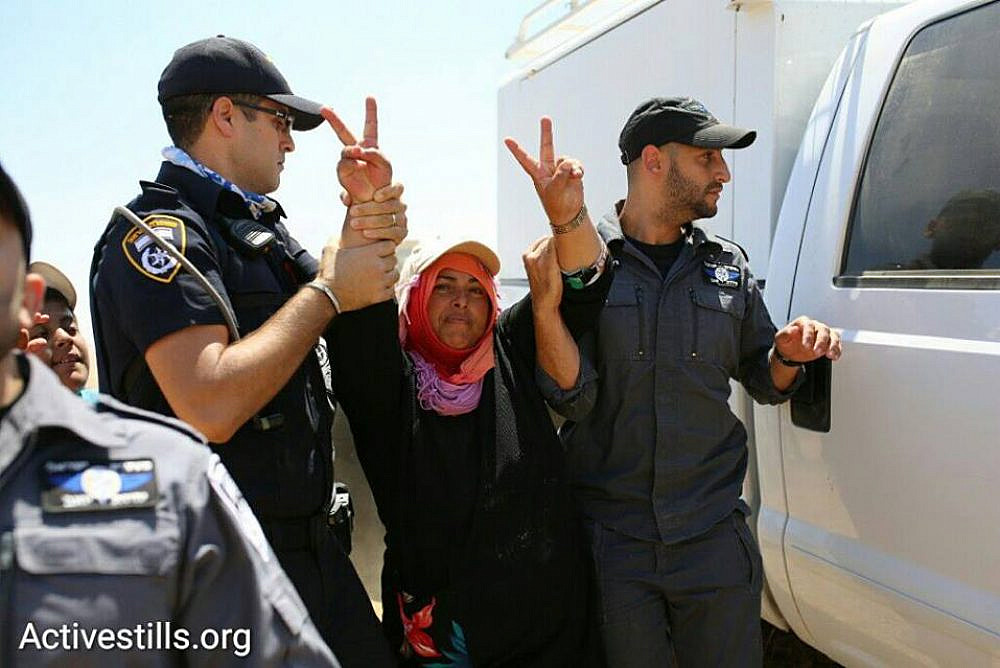
In the Naqab live 110,000 Muslim Bedouins. The Israeli government built seven development towns for them between 1979 and 1982, but roughly half of Bedouin Israelis live in villages that are not connected to an electrical grid or water mains, as the state does not recognize them (despite the fact that they have been living on these lands longer than the existence of the State of Israel). A new law, the Begin-Prawer Plan , which passed its first reading in June 2013, proposed the destruction of up to 40 Bedouin villages, on the ruins of which the JNF will plant forests and establish Jewish-only settlements. This is part of the JNF plan, called “Blueprint Negev” (26). The government plans to expel up to 70,000 Bedouins in order for the JNF’s plan to come to fruition. Israel has refused to listen to any arguments or counter-proposals from the Bedouin community. This Bedouin removal is only the latest stage of an effort that has been going on now for many years to displace Bedouin citizens of Israel from their ancestral lands. While Benny Begin announced that the plan was being halted, Major General Doron Almog– whose in charge of implementing the plan– claims that he has received no orders to shelve the plan, and is continuing towards its implementation (27).
Endnotes:
(1) Over 80% of the approximately 950,000 original inhabitants fled or were expelled in 1948 and have not been allowed to return.
(2) Amara, Muhammad and Izhak Schnell. “Identity Repertoires among Arabs in Israel.” Journal of Ethnic and Migration Studies30, 2004, 175–193.
(3) Elmont, Jon. “In Protests Against Prawer Plan, Signs of ‘Palestinization’ in Israel’s Bedouin Minority,” Tablet, December 5, 2013.
(4) Stern, Yoav: “Christian Arabs– Israel’s Christian Arabs don’t want to fight to fit in,” Haaretz, 23 March 2005.
(5) Cook, Jonathan: Blood and Religion: The Unmasking of the Jewish and Democratic State, London: Pluto Press, 2006.
(6) Sedan, Gil: “Netanyahu: Israel’s Arabs are the real demographic threat.” Haaretz, 2003-18-18.
(7) Shamir, Shimon: “The Arabs in Israel–Two Years after the Or Commission Report.” 19 September 2005.
(8) White, Ben. Palestinians in Israel. London: Pluto Press, 2012.
(9) Goldenberg, Tia “Supreme Court rejects Israeli nationality status,” The Times of Israel, Oct. 4, 2013.
(10) The Zionist Idea. The Jewish Publication Society, 1997, p. 245.
(11) International Crisis Group, “Identity Crisis: Israel and its Arab Citizens,” Middle East Report No 25,4 March, 2004.
(12) Torstrick, Rebecca L.: The Limits of Coexistence: Identity Politics in Israel. University of Michigan Press, 2000, p.13.
(13) Tessler, Mark and Audra K Grant: “Israel’s Arab Citizens: The Continuing Struggle.” Annals of the American Academy of Political Science555, January 1998, pp.97–113.
(14) Discriminatory Laws in Israel, Adalah
(15) Cook, Jonathan and Alexander Key, Silencing Dissent Report, Arab Association for Human Rights, October 2002.
(16) See note 8.
(17) “The Arab Citizens of Israel and the 2006 War in Lebanon” (PDF).
(18) Gilady, Eival, “The Galilee as a challenge and natonal priority.” Herzliya Conference, 23 January 2006.
(19) “The equality index of Jewish and Arab citizens in Israel.” Sikkuy, 2009.
(20) The Guttman Center’s Democracy Index for 2007.
(21) “Jews, Arabs Debate Internal Arab Threat.” Israel National News, 17 May, 2010.
(22) Internal Displacement Monitoring Center – Israel.
(23) Access Denied: Palestinian Land Rights in Israel, Zed Books, London: 2003, p. 136.
(24) “Land Controlled by Jewish National Fund for Jews Only.” Adalah, 29, July 2007.
(25) “The Jewish National Fund and the Rights of the Bedouin,”T’ruah
(26) “Demolition and Eviction of Bedouin Citizens of Israel in the Naqab (Negev),” Adalah.
(27) Zonszein, Mairav, “Prawer Plan may not be shelved after all,” Haaretz, December 16, 2013.
